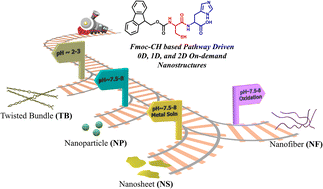Microfluidic-driven ultrafast self-assembly of a dipeptide into stimuli-responsive 0D, 1D, and 2D nanostructures and as hydrolase mimic†
Abstract
Numerous peptides have been utilized to explore the efficacy of their self-assembly to produce nanostructures to mimic the self-organization capability of biomolecules in nature. Self-assembled nanostructures have significant applicability for a range of diverse applications. While the ability to create self-assembled functional materials has greatly improved, the self-assembly process, which results in ordered 0D, 1D, and 2D nanostructures, is still time-consuming. Moreover, in situ structural transformation from one self-assembled structure to another with different dimensions presents an additional challenge. Therefore, in this report, we demonstrate self-assembly in an ultrafast fashion to access four different nanostructures, namely, twisted bundle (TB), nanoparticle (NP), nanofiber (NF), and nanosheet (NS), from a simple dipeptide with the aid of simple microfluidic reactors by applying different stimuli. Additionally, an integrated microfluidic system enabled rapid structural switchover between two types in an ultrashort period of time. It is interesting to note that the formation of the twisted bundle (TB) morphology enabled the formation of an extended entangled network, which resulted in the formation of a hydrogel (1 w/v%). In addition, the nanostructures obtained using the ultrafast self-assembly process were investigated to study their hydrolase enzyme activity mimicking performance against a model substrate (p-NPA) reaction. Intriguingly, we found that our nanostructures were suitably well ordered, and when taking molecular mass into consideration, showed improved catalytic efficiency as compared to the native enzymes.



 Please wait while we load your content...
Please wait while we load your content...